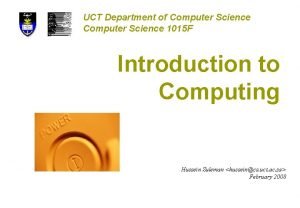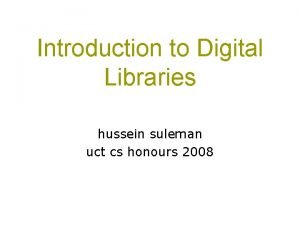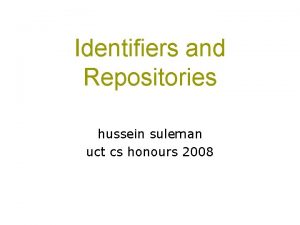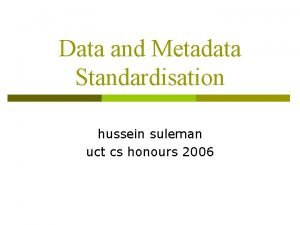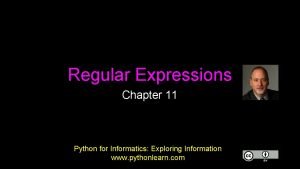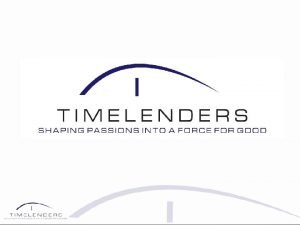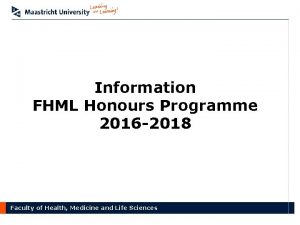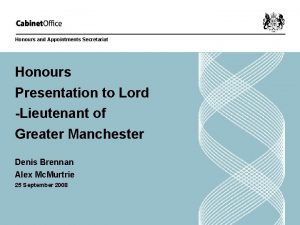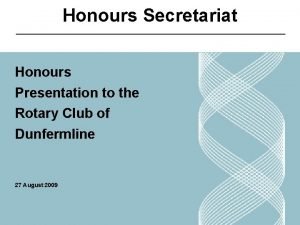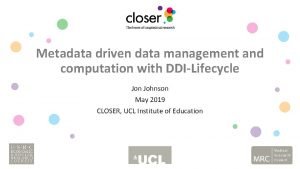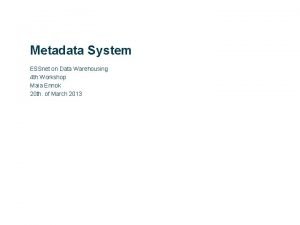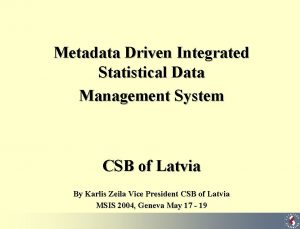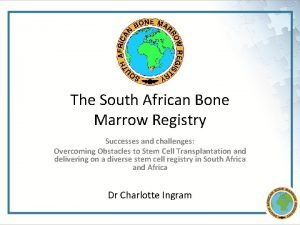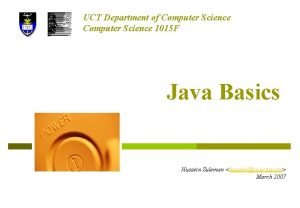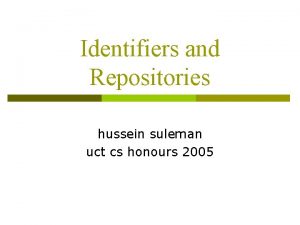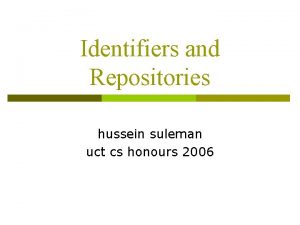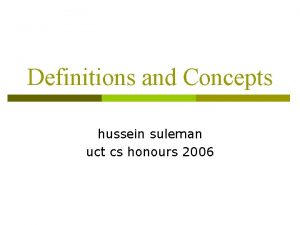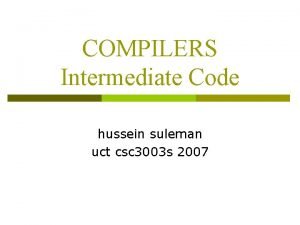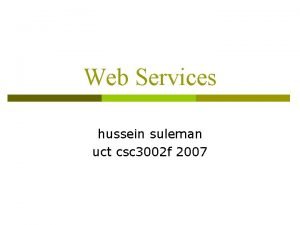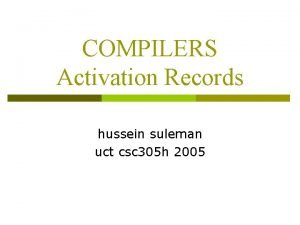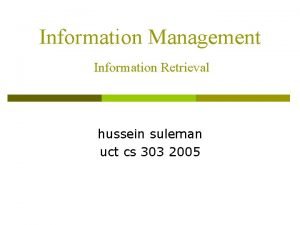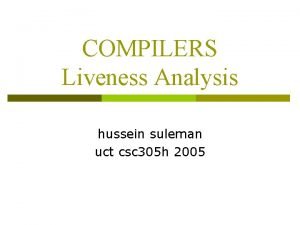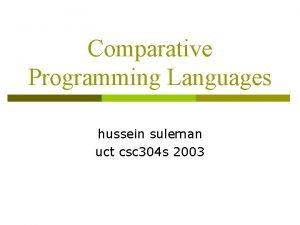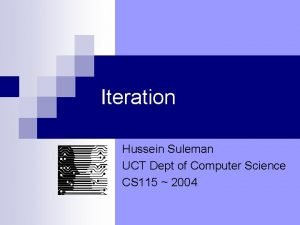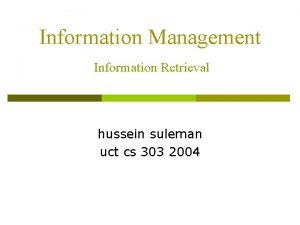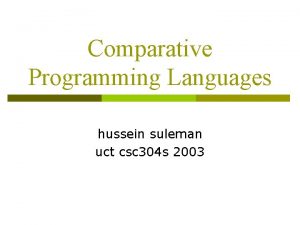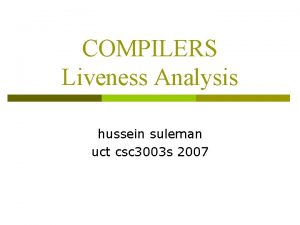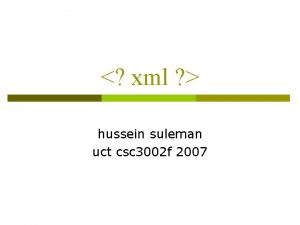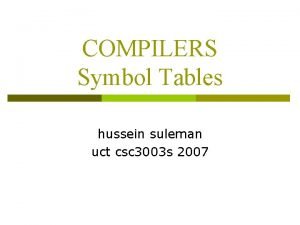Metadata hussein suleman uct cs honours 2008 Data






















- Slides: 22

Metadata hussein suleman uct cs honours 2008

Data vs. Metadata Data refers to digital objects that contain useful information for information seekers. Metadata refers to standardised descriptions of objects, digital or physical. Many systems manipulate metadata records, which contain pointers to the actual data. The definition is fuzzy as metadata contains useful information as well and in some cases could contain all the data e. g. , metadata describing a person.

An Example of Metadata Object: Metadata name: chalk owner: hussein colour: white size: 2. 5 description: used to write on board location: honours lecture room source: Waltons Stationers

Another Metadata Example Object: Metadata colour: white title: RG 123 owner: UCT lifetime: 2 months size: 1 identifier: RG 123 description: white powdery stick

Metadata Comparisons Metadata colour: white title: RG 123 owner: UCT lifetime: 2 months size: 1 identifier: RG 123 description: white powdery stick Metadata name: chalk owner: hussein colour: white size: 2. 5 description: used to write on board location: honours lecture room source: Waltons Stationers What problems can occur?

Types of Metadata Descriptive Structural location, identifier, submitter, … Preservation part, subpart, relation, child, … Administrative title, author, type, format, … resolution, capture device, watermark, … Provenance source archive, previous version, source format, …

Creating Metadata Follow metadata guidelines. Use terms from controlled vocabularies. Avoid duplication of information across fields. Use accepted standards for common elements. e. g. , ISO 8601 for dates 2005 -03 -03 instead of 03/03/05 Use XML-based encoding according to standardised Schema/DTD.

Dublin Core is one of the most popular and simplest metadata formats. 15 elements with recommended semantics. All elements are optional and repeatable.

DC in HTML <META NAME=DC. Creator CONTENT="Tony Gill"> <META NAME=DC. Title CONTENT="ADAM Quick Guide to Metadata"> <META NAME=DC. Subject CONTENT="ADAM, Dublin Core, internet cataloguing, metadata"> <META NAME=DC. Description CONTENT="A short ADAM guide to metadata, particularly Dublin Core. "> <META NAME=DC. Date CONTENT="1997 -11 -21"> Source: http: //adam. ac. uk/adam/metadata. html

DC Metadata in XML <title>02 uct 1</title> <creator>Hussein Suleman</creator> <subject>Visit to UCT </subject> <description>the view that greets you as you emerge from the tunnel under the freeway WOW - and, no, the mountain isnt that close - it just looks that way in 2 D</description> <publisher>Hussein Suleman</publisher> <date>2002 -11 -27</date> <type>image</type> <format>image/jpeg</format>

DC Metadata in Valid Qualified XML <oaidc: dc xmlns="http: //purl. org/dc/elements/1. 1/" xmlns: oaidc="http: //www. openarchives. org/OAI/2. 0/oai_dc/" xmlns: xsi="http: //www. w 3. org/2001/XMLSchema-instance" xsi: schema. Location="http: //www. openarchives. org/OAI/2. 0/oai_dc/ http: //www. openarchives. org/OAI/2. 0/oai_dc. xsd"> <title>02 uct 1</title> <creator>Hussein Suleman</creator> <subject>Visit to UCT </subject> <description>the view that greets you as you emerge from the tunnel under the freeway - WOW - and, no, the mountain isnt that close - it just looks that way in 2 -D</description> <publisher>Hussein Suleman</publisher> <date>2002 -11 -27</date> <type>image</type> <format>image/jpeg</format> <identifier>http: //www. husseinsspace. com/pictures/200230 uct/02 uct 1. jpg </identifier> <language>en-us</language> <relation>http: //www. husseinsspace. com</relation> <rights>unrestricted</rights> </oaidc: dc>

DC Qualifiers Dublin Core has been considered TOO simple for many applications – not enough semantics. Some DC terms have had qualifiers added to make the meaning more specific. For example, date. created instead of just date relation. has. Part instead of just relation In general, q. DC can be dumbed-down (that’s a technical term in interoperability) to DC by ignoring qualifications.

What Metadata Format? Do NOT just use Dublin Core all the time! Every project has its own metadata/data requirements, therefore most use an internal format. For maximum interoperability, Map metadata to most descriptive format for use by close collaborators. Map metadata to DC for use by all and sundry. How do we “map” metadata formats?

Metadata Transformation Use XML parser to parse data. Use SAX/DOM to extract individual elements and generate new format. Example (to convert UCT to DC): my $parser = new DOMParser; my $document = $parser->parsefile (‘uct. xml’)->get. Document. Element; foreach my $title ($document->get. Elements. By. Tag. Name (‘title’)) { print “<title>”. $title->get. First. Child->get. Data. ”</title>n”; } foreach my $author ($document->get. Elements. By. Tag. Name (‘author’)) { print “<creator>”. $author->get. First. Child->get. Data. ”</creator>n”; } print “<publisher>UCT</publisher>n”; foreach my $version ($document->get. Elements. By. Tag. Name (‘version’)) { foreach my $number ($version->get. Elements. By. Tag. Name (‘number’)) { print “<identifier>”. $number->get. First. Child->get. Data. ”</identifier>n”; } } There must be an easier way …

Metadata Transformation (XSLT) 1/2 <stylesheet version='1. 0' xmlns='http: //www. w 3. org/1999/XSL/Transform' xmlns: oaidc='http: //www. openarchives. org/OAI/2. 0/oai_dc/' xmlns: dc='http: //purl. org/dc/elements/1. 1/' xmlns: xsi='http: //www. w 3. org/2001/XMLSchema-instance' xmlns: uct='http: //www. uct. ac. za' > <!-UCT to DC transformation Hussein Suleman v 1. 0 : 24 July 2003 --> <output method="xml"/> <variable name="institution"><text>UCT</text></variable>

Metadata Transformation (XSLT) 2/2 <template match="uct: uct"> <oaidc: dc xsi: schema. Location="http: //www. openarchives. org/OAI/2. 0/oai_dc/ http: //www. openarchives. org/OAI/2. 0/oai_dc. xsd"> <dc: title><value-of select="uct: title"/></dc: title> <apply-templates select="uct: author"/> <element name="dc: publisher"> <value-of select="$institution"/> </element> <apply-templates select="uct: version"/> </oaidc: dc> </template> <template match="uct: author"> <dc: creator> <value-of select=". "/> </dc: creator> </template> <template match="uct: version"> <dc: identifier> <value-of select="uct: number"/> </dc: identifier> </template> </stylesheet> Ok, but map to what?

Example: RFC 1807 <rfc 1807 xmlns="http: //info. internet. isi. edu: 80/in-notes/rfc/files/rfc 1807. txt“ xmlns: xsi="http: //www. w 3. org/2001/XMLSchema-instance“ xsi: schema. Location="http: //info. internet. isi. edu: 80/in-notes/rfc/files/rfc 1807. txt http: //www. openarchives. org/OAI/1. 1/rfc 1807. xsd"> <bib-version >1</bib-version> <id >395</id> <entry >2007 -01 -01</entry> <organization >University of Cape Town - Department of Computer Science</organization> <title >Using Payment Gateways to Maintain Privacy in Secure Electronic Transactions</title> <type >Conference Paper</type> <author >Arnab, Alapan</author> <author >Hutchison, Andrew</author> <other_access >url: http: //pubs. cs. uct. ac. za/archive/00000395/</other_access> <language >en</language> <abstract >Because many current payment systems are poorly implemented, or of incompetence, private data of consumers such as payment details, addresses and their purchase history can be compromised. Furthermore, current payment systems do not offer any non-repudiable verification to a completed transaction, which poses risks to all the parties of the transaction - the consumer, the merchant and the financial institution. One solution to this problem was SET, but it was never really a success because of its complexity and poor reception from consumers. In this paper, we introduce a third party payment system that aims to preserve privacy by severing the link between their purchase and payment records, while providing a traceable transaction that maintains its integrity and is non-repudiable. Our system also removes much of the responsibilities placed on the merchant with regards to securing sensitive data related to customer payment, thus increasing the potential of small businesses to take part in e-commerce without significant investments in computer security. </abstract> </rfc 1807>

Example: MARC <marc: record xmlns: marc="http: //www. loc. gov/MARC 21/slim" xmlns: xsi="http: //www. w 3. org/2001/XMLSchemainstance" xsi: schema. Location="http: //www. loc. gov/MARC 21/slim http: //www. loc. gov/standards/marcxml/schema/MARC 21 slim. xsd" type="Bibliographic"> <marc: leader>00000 coc 2200000 uu 4500</marc: leader> <marc: controlfield tag="001">444652</marc: controlfield> <marc: controlfield tag="003">Sz. Ge. CERN</marc: controlfield> <marc: datafield tag="035" <marc: subfield </marc: datafield> <marc: datafield tag="037" <marc: subfield </marc: datafield> <marc: datafield tag="041" <marc: subfield </marc: datafield> <marc: datafield tag="088" <marc: subfield </marc: datafield> ind 1="" ind 2=""> code="9">CERCER</marc: subfield> code="a">2195309</marc: subfield> ind 1="" ind 2=""> code="a">nlin. SI/0006040</marc: subfield> ind 1="" ind 2=""> code="a">eng</marc: subfield> ind 1="" ind 2=""> code="9">nlin/0006040</marc: subfield> <marc: datafield tag="100" ind 1="" ind 2=""> <marc: subfield code="a">Bibikov, P N</marc: subfield> </marc: datafield> <marc: datafield tag="245" ind 1="" ind 2=""> <marc: subfield code="a">Derivation of R-matrix from local Hamiltonian density</marc: subfield> </marc: datafield> <marc: datafield tag="260" ind 1="" ind 2=""> <marc: subfield code="c">2000</marc: subfield> </marc: datafield> <marc: datafield tag="269" ind 1="" ind 2=""> <marc: subfield code="a">Geneva</marc: subfield> <marc: subfield code="b">CERN</marc: subfield> <marc: subfield code="c">23 Jun 2000</marc: subfield> </marc: datafield> <marc: datafield tag="300" ind 1="" ind 2=""> <marc: subfield code="a">18 p</marc: subfield> </marc: datafield> <marc: datafield tag="520" ind 1="" ind 2=""> <marc: subfield code="a">A computer algebra algoritm for solving the quantum Yang-Baxter equation is presented. It is based on the Taylor expansion of R-matrix which is developed up to the order lambda^6. As an example the classification of 4 x 4 R-matrices is given. </marc: subfield> </marc: datafield> <marc: datafield tag="595" ind 1="" ind 2=""> <marc: subfield code="a">LANL EDS</marc: subfield> </marc: datafield> <marc: datafield tag="650" ind 1="1" ind 2="7"> <marc: subfield code="2">Sz. Ge. CERN</marc: subfield> <marc: subfield code="a">Nonlinear Systems</marc: subfield> </marc: datafield> <marc: datafield tag="690" ind 1="C" ind 2=""> <marc: subfield code="a">PREPRINT</marc: subfield> </marc: datafield> <marc: datafield tag="690" ind 1="C" ind 2=""> <marc: subfield code="a">CERN</marc: subfield> </marc: datafield> <marc: datafield tag="695" ind 1="" ind 2=""> <marc: subfield code="9">LANL EDS</marc: subfield> <marc: subfield code="a">Exactly Solvable and Integrable Systems</marc: subfield> </marc: datafield> <marc: datafield tag="695" ind 1="" ind 2=""> <marc: subfield code="9">LANL EDS</marc: subfield> <marc: subfield code="a">Nonlinear Sciences</marc: subfield> </marc: datafield> <marc: datafield tag="710" ind 1="" ind 2=""> <marc: subfield code="5">CERN? </marc: subfield> </marc: datafield> <marc: datafield tag="856" ind 1="4" ind 2=""> <marc: subfield code="u">http: //documents. cern. ch/cgi-bin/setlink? base=preprint& categ=nlin. SI& id=0006040</marc: subfield> <marc: subfield code="y">Access to fulltext document</marc: subfield> </marc: datafield> <marc: datafield tag="859" ind 1="" ind 2=""> <marc: subfield code="f">sergey. paston@pobox. spbu. ru>David Dallman < David. Dallman@cern. ch</marc: subfield> </marc: datafield> <marc: datafield tag="916" ind 1="" ind 2=""> <marc: subfield code="s">n</marc: subfield> <marc: subfield code="w">200026</marc: subfield> </marc: datafield> <marc: datafield tag="960" ind 1="" ind 2=""> <marc: subfield code="a">11</marc: subfield> </marc: datafield> <marc: datafield tag="961" ind 1="" ind 2=""> <marc: subfield code="c">20060112</marc: subfield> <marc: subfield code="h">1202</marc: subfield> <marc: subfield code="l">CER 01</marc: subfield> <marc: subfield code="x">20000626</marc: subfield> </marc: datafield> <marc: datafield tag="963" ind 1="" ind 2=""> <marc: subfield code="a">PUBLIC</marc: subfield> </marc: datafield> <marc: datafield tag="970" ind 1="" ind 2=""> <marc: subfield code="a">002195309 CER</marc: subfield> </marc: datafield> <marc: datafield tag="980" ind 1="" ind 2=""> <marc: subfield code="a">PREPRINT</marc: subfield> </marc: datafield> </marc: record>

Example: VRA-Core

Other Metadata Standards IMS Metadata Specification EAD Descriptive, administrative and structural encoding for metadata of digital objects MODS Library finding aids to locate archived items. METS Courseware object description. Richer than DC, subset of MARC 21 MPEG 21 -DIDL Structural descriptions of complex multimedia objects

Automatic Metadata Extraction Create metadata automatically from a digital object. Embedded Metadata Heuristic Techniques e. g. , The first string that looks like a date is the date of publication Machine Learning e. g. , MP 3 tags e. g. , Neural networks Dictionary Techniques e. g. , If it looks like a name, it could be an author

References Dublin Core Metadata Initiative (2005). DCMI Metadata Terms. Available http: //dublincore. org/documents/dcmi-terms/ Dublin Core Metadata Initiative (2004). Dublin Core Metadata Element Set, Version 1. 1: Reference Description. Available http: //dublincore. org/documents/dces/ IMS Global Learning Consortium, Inc. (2001). IMS Learning Resource Meta-Data Information Model, Version 1. 2. 1 Final Specification. Available http: //www. imsglobal. org/metadata/imsmdv 1 p 2 p 1/imsmd_infov 1 p 2 p 1. html Lasher, R. and D. Cohen (1995). A Format for Bibliographic Records. Network Working Group, RFC 1807. Available http: //www. ietf. org/rfc 1807. txt Library of Congress (2002). Encoded Archival Description (EAD), Official EAD Version 2002 Web Site. Website http: //www. loc. gov/ead/ Library of Congress (2005). MARC Standards. Website http: //www. loc. gov/marc/ Library of Congress (2005). Metadata Encoding and Transmission Standard. Website http: //www. loc. gov/standards/mets/ Library of Congress (2005). Metadata Object Description Schema. Website http: //www. loc. gov/standards/mods/ Visual Resources Association Data Standards Committee. (2007). VRA Core 4. 0. Available http: //www. vraweb. org/projects/vracore 4/index. html XML Cover Pages (2005). MPEG-21 Part 2: Digital Item Declaration Language (DIDL). Website http: //xml. coverpages. org/mpeg 21 -didl. html
 Uct computer science
Uct computer science Hussein suleman
Hussein suleman Hussein suleman
Hussein suleman Reporaproblem
Reporaproblem Hussein suleman
Hussein suleman From [email protected] sat jan 5 09:14:16 2008
From [email protected] sat jan 5 09:14:16 2008 Suleman ahmer
Suleman ahmer 2008 2008
2008 2008 Ask fhml
Ask fhml Honours and appointments secretariat
Honours and appointments secretariat Uco bank honours your trust
Uco bank honours your trust Honours secretariat
Honours secretariat Exeter fch
Exeter fch Honours college leiden
Honours college leiden Bachelor of pharmaceutical science advanced with honours
Bachelor of pharmaceutical science advanced with honours Metadata-driven data management
Metadata-driven data management Metadata layer data warehouse
Metadata layer data warehouse Metadata-driven data management
Metadata-driven data management Prague chemistry university
Prague chemistry university Combat systems officer training
Combat systems officer training Uct summer school
Uct summer school Nadia chalkley uct
Nadia chalkley uct Uct computer science
Uct computer science
